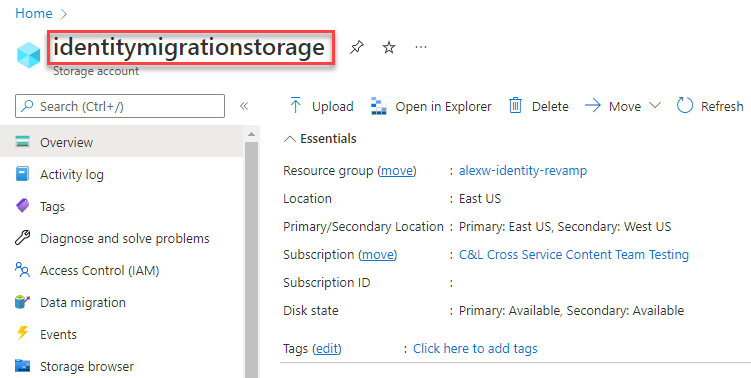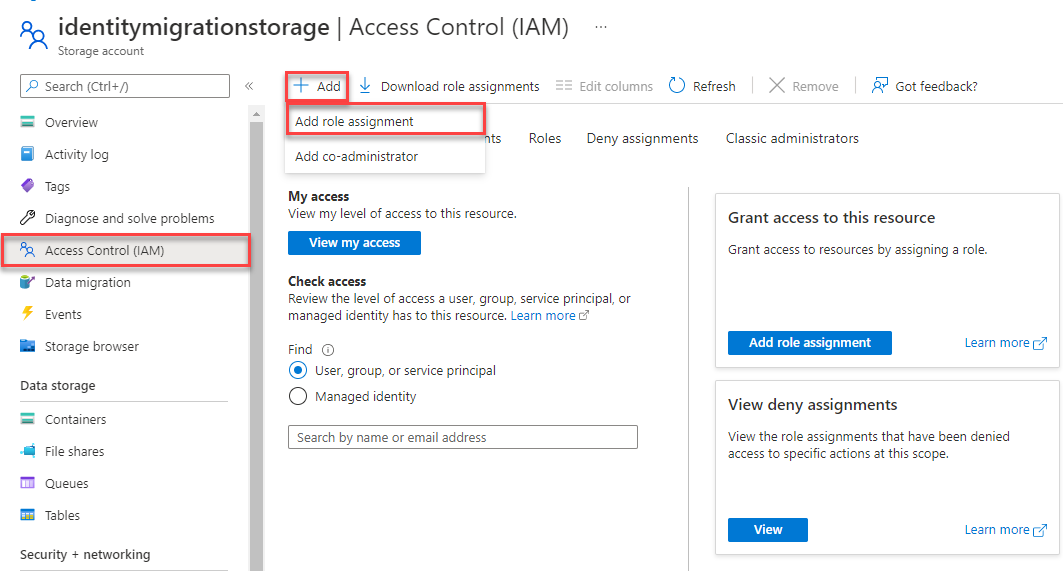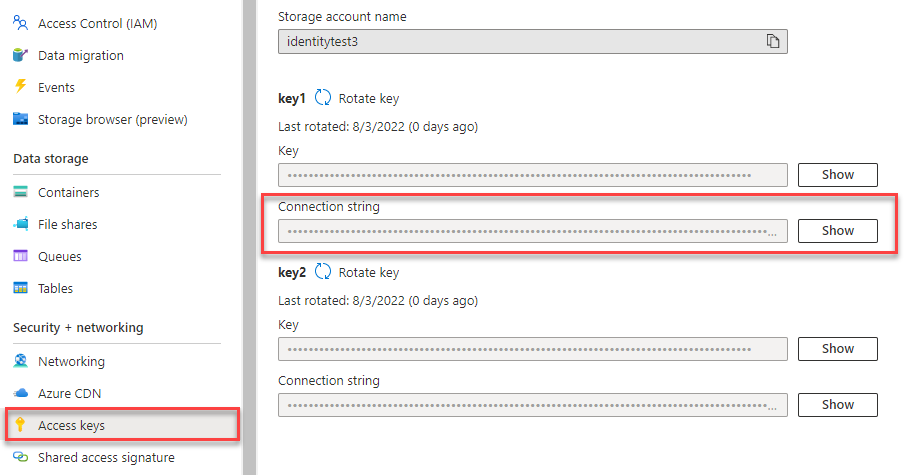Note
Access to this page requires authorization. You can try signing in or changing directories.
Access to this page requires authorization. You can try changing directories.
Get started with the Azure Blob Storage client library for Node.js to manage blobs and containers.
In this article, you follow steps to install the package and try out example code for basic tasks. API reference | Library source code | Package (npm) | Samples
Prerequisites
- Azure account with an active subscription - create an account for trial
- Azure Storage account - Create a storage account
- Node.js LTS
Setting up
This section walks you through preparing a project to work with the Azure Blob Storage client library for Node.js.
Create the Node.js project
Create a JavaScript application named blob-quickstart.
In a console window (such as cmd, PowerShell, or Bash), create a new directory for the project:
mkdir blob-quickstartSwitch to the newly created blob-quickstart directory:
cd blob-quickstartCreate a package.json file:
npm init -yOpen the project in Visual Studio Code:
code .
Install the packages
From the project directory, install the following packages using the npm install command.
Install the Azure Storage npm package:
npm install @azure/storage-blobInstall the Azure Identity npm package for a passwordless connection:
npm install @azure/identityInstall other dependencies used in this quickstart:
npm install uuid dotenv
Set up the app framework
From the project directory:
- Create a new file named
index.js - Copy the following code into the file:
const { BlobServiceClient } = require("@azure/storage-blob");
const { v1: uuidv1 } = require("uuid");
require("dotenv").config();
async function main() {
try {
console.log("Azure Blob storage v12 - JavaScript quickstart sample");
// Quick start code goes here
} catch (err) {
console.err(`Error: ${err.message}`);
}
}
main()
.then(() => console.log("Done"))
.catch((ex) => console.log(ex.message));
Object model
Azure Blob storage is optimized for storing massive amounts of unstructured data. Unstructured data is data that doesn't adhere to a particular data model or definition, such as text or binary data. Blob storage offers three types of resources:
- The storage account
- A container in the storage account
- A blob in the container
The following diagram shows the relationship between these resources.

Use the following JavaScript classes to interact with these resources:
- BlobServiceClient: The
BlobServiceClientclass allows you to manipulate Azure Storage resources and blob containers. - ContainerClient: The
ContainerClientclass allows you to manipulate Azure Storage containers and their blobs. - BlobClient: The
BlobClientclass allows you to manipulate Azure Storage blobs.
Code examples
These example code snippets show you how to do the following tasks with the Azure Blob Storage client library for JavaScript:
- Authenticate to Azure and authorize access to blob data
- Create a container
- Upload blobs to a container
- List the blobs in a container
- Download blobs
- Delete a container
Sample code is also available on GitHub.
Authenticate to Azure and authorize access to blob data
Application requests to Azure Blob Storage must be authorized. Using the DefaultAzureCredential class provided by the Azure Identity client library is the recommended approach for implementing passwordless connections to Azure services in your code, including Blob Storage.
You can also authorize requests to Azure Blob Storage by using the account access key. However, this approach should be used with caution. Developers must be diligent to never expose the access key in an unsecure location. Anyone who has the access key is able to authorize requests against the storage account, and effectively has access to all the data. DefaultAzureCredential offers improved management and security benefits over the account key to allow passwordless authentication. Both options are demonstrated in the following example.
DefaultAzureCredential supports multiple authentication methods and determines which method should be used at runtime. This approach enables your app to use different authentication methods in different environments (local vs. production) without implementing environment-specific code.
The order and locations in which DefaultAzureCredential looks for credentials can be found in the Azure Identity library overview.
For example, your app can authenticate using your Azure CLI sign-in credentials with when developing locally. Your app can then use a managed identity once it's deployed to Azure. No code changes are required for this transition.
Assign roles to your Microsoft Entra user account
When developing locally, make sure that the user account that is accessing blob data has the correct permissions. You'll need Storage Blob Data Contributor to read and write blob data. To assign yourself this role, you'll need to be assigned the User Access Administrator role, or another role that includes the Microsoft.Authorization/roleAssignments/write action. You can assign Azure RBAC roles to a user using the Azure portal, Azure CLI, or Azure PowerShell. For more information about the Storage Blob Data Contributor role, see Storage Blob Data Contributor. For more information about the available scopes for role assignments, see Understand scope for Azure RBAC.
In this scenario, you'll assign permissions to your user account, scoped to the storage account, to follow the Principle of Least Privilege. This practice gives users only the minimum permissions needed and creates more secure production environments.
The following example will assign the Storage Blob Data Contributor role to your user account, which provides both read and write access to blob data in your storage account.
Important
In most cases it will take a minute or two for the role assignment to propagate in Azure, but in rare cases it may take up to eight minutes. If you receive authentication errors when you first run your code, wait a few moments and try again.
In the Azure portal, locate your storage account using the main search bar or left navigation.
On the storage account overview page, select Access control (IAM) from the left-hand menu.
On the Access control (IAM) page, select the Role assignments tab.
Select + Add from the top menu and then Add role assignment from the resulting drop-down menu.
Use the search box to filter the results to the desired role. For this example, search for Storage Blob Data Contributor and select the matching result and then choose Next.
Under Assign access to, select User, group, or service principal, and then choose + Select members.
In the dialog, search for your Microsoft Entra username (usually your user@domain email address) and then choose Select at the bottom of the dialog.
Select Review + assign to go to the final page, and then Review + assign again to complete the process.
Sign in and connect your app code to Azure using DefaultAzureCredential
You can authorize access to data in your storage account using the following steps:
Make sure you're authenticated with the same Microsoft Entra account you assigned the role to on your storage account. You can authenticate via the Azure CLI, Visual Studio Code, or Azure PowerShell.
Sign-in to Azure through the Azure CLI using the following command:
az loginTo use
DefaultAzureCredential, make sure that the @azure\identity package is installed, and the class is imported:const { DefaultAzureCredential } = require('@azure/identity');Add this code inside the
tryblock. When the code runs on your local workstation,DefaultAzureCredentialuses the developer credentials of the prioritized tool you're logged into to authenticate to Azure. Examples of these tools include Azure CLI or Visual Studio Code.const accountName = process.env.AZURE_STORAGE_ACCOUNT_NAME; if (!accountName) throw Error('Azure Storage accountName not found'); const blobServiceClient = new BlobServiceClient( `https://${accountName}.blob.core.chinacloudapi.cn`, new DefaultAzureCredential() );Make sure to update the storage account name,
AZURE_STORAGE_ACCOUNT_NAME, in the.envfile or your environment's variables. The storage account name can be found on the overview page of the Azure portal.
Note
When deployed to Azure, this same code can be used to authorize requests to Azure Storage from an application running in Azure. However, you'll need to enable managed identity on your app in Azure. Then configure your storage account to allow that managed identity to connect. For detailed instructions on configuring this connection between Azure services, see the Auth from Azure-hosted apps tutorial.
Create a container
Create a new container in the storage account. The following code example takes a BlobServiceClient object and calls the getContainerClient method to get a reference to a container. Then, the code calls the create method to actually create the container in your storage account.
Add this code to the end of the try block:
// Create a unique name for the container
const containerName = 'quickstart' + uuidv1();
console.log('\nCreating container...');
console.log('\t', containerName);
// Get a reference to a container
const containerClient = blobServiceClient.getContainerClient(containerName);
// Create the container
const createContainerResponse = await containerClient.create();
console.log(
`Container was created successfully.\n\trequestId:${createContainerResponse.requestId}\n\tURL: ${containerClient.url}`
);
To learn more about creating a container, and to explore more code samples, see Create a blob container with JavaScript.
Important
Container names must be lowercase. For more information about naming containers and blobs, see Naming and Referencing Containers, Blobs, and Metadata.
Upload blobs to a container
Upload a blob to the container. The following code gets a reference to a BlockBlobClient object by calling the getBlockBlobClient method on the ContainerClient from the Create a container section.
The code uploads the text string data to the blob by calling the upload method.
Add this code to the end of the try block:
// Create a unique name for the blob
const blobName = 'quickstart' + uuidv1() + '.txt';
// Get a block blob client
const blockBlobClient = containerClient.getBlockBlobClient(blobName);
// Display blob name and url
console.log(
`\nUploading to Azure storage as blob\n\tname: ${blobName}:\n\tURL: ${blockBlobClient.url}`
);
// Upload data to the blob
const data = 'Hello, World!';
const uploadBlobResponse = await blockBlobClient.upload(data, data.length);
console.log(
`Blob was uploaded successfully. requestId: ${uploadBlobResponse.requestId}`
);
The preceding code gets a reference to a BlockBlobClient object by calling the getBlockBlobClient method on the ContainerClient from the Create a container section. The code uploads the text string data to the blob by calling the upload method.
To learn more about uploading blobs, and to explore more code samples, see Upload a blob with JavaScript.
List the blobs in a container
List the blobs in the container. The following code calls the listBlobsFlat method. In this case, only one blob is in the container, so the listing operation returns just that one blob.
Add this code to the end of the try block:
console.log('\nListing blobs...');
// List the blob(s) in the container.
for await (const blob of containerClient.listBlobsFlat()) {
// Get Blob Client from name, to get the URL
const tempBlockBlobClient = containerClient.getBlockBlobClient(blob.name);
// Display blob name and URL
console.log(
`\n\tname: ${blob.name}\n\tURL: ${tempBlockBlobClient.url}\n`
);
}
The preceding code calls the listBlobsFlat method. In this case, only one blob has been added to the container, so the listing operation returns just that one blob.
To learn more about listing blobs, and to explore more code samples, see List blobs with JavaScript.
Download blobs
Download the blob and display the contents. The following code calls the download method to download the blob.
Add this code to the end of the try block:
// Get blob content from position 0 to the end
// In Node.js, get downloaded data by accessing downloadBlockBlobResponse.readableStreamBody
// In browsers, get downloaded data by accessing downloadBlockBlobResponse.blobBody
const downloadBlockBlobResponse = await blockBlobClient.download(0);
console.log('\nDownloaded blob content...');
console.log(
'\t',
await streamToText(downloadBlockBlobResponse.readableStreamBody)
);
The following code converts a stream back into a string to display the contents.
Add this code after the main function:
// Convert stream to text
async function streamToText(readable) {
readable.setEncoding('utf8');
let data = '';
for await (const chunk of readable) {
data += chunk;
}
return data;
}
To learn more about downloading blobs, and to explore more code samples, see Download a blob with JavaScript.
Delete a container
Delete the container and all blobs within the container. The following code cleans up the resources created by the app by removing the entire container using the delete method.
Add this code to the end of the try block:
// Delete container
console.log('\nDeleting container...');
const deleteContainerResponse = await containerClient.delete();
console.log(
'Container was deleted successfully. requestId: ',
deleteContainerResponse.requestId
);
To learn more about deleting a container, and to explore more code samples, see Delete and restore a blob container with JavaScript.
Run the code
From a Visual Studio Code terminal, run the app.
node index.js
The output of the app is similar to the following example:
Azure Blob storage - JavaScript quickstart sample
Creating container...
quickstart4a0780c0-fb72-11e9-b7b9-b387d3c488da
Uploading to Azure Storage as blob:
quickstart4a3128d0-fb72-11e9-b7b9-b387d3c488da.txt
Listing blobs...
quickstart4a3128d0-fb72-11e9-b7b9-b387d3c488da.txt
Downloaded blob content...
Hello, World!
Deleting container...
Done
Step through the code in your debugger and check your Azure portal throughout the process. Check to see that the container is being created. You can open the blob inside the container and view the contents.
Clean up resources
- When you're done with this quickstart, delete the
blob-quickstartdirectory. - If you're done using your Azure Storage resource, use the Azure CLI to remove the Storage resource.

